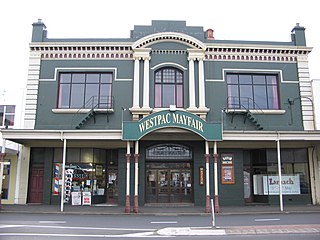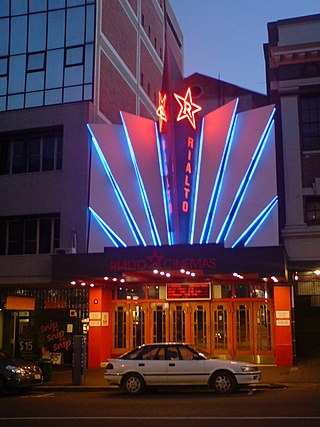
Queen Street is the major commercial thoroughfare in the Auckland CBD, Auckland, New Zealand's largest city. The northern end is at Queens Wharf on the Auckland waterfront, adjacent to the Britomart Transport Centre and the Downtown Ferry Terminal. The road is close to straight, the southern end being almost three kilometres away in a south-southwesterly direction on the Karangahape Road ridge, close to the residential suburbs in the interior of the Auckland isthmus.

The CAA Ed Mirvish Theatre is a historic performing arts theatre in Toronto, Ontario, located near Yonge–Dundas Square. Owned and operated by Mirvish Productions, the theatre has approximately 2,300 seats across two levels. There are two entrances to the theatre, located at 263 Yonge Street and 244 Victoria Street.

Karangahape Road is one of the main streets in the central business district (CBD) of Auckland, New Zealand. The massive expansion of motorways through the nearby inner city area – and subsequent flight of residents and retail into the suburbs from the 1960s onwards – turned it from one of Auckland's premier shopping streets into a marginal area with the reputation of a red-light district. Now considered to be one of the cultural centres of Auckland, since the 1980s–1990s it has been undergoing a slow process of gentrification, and is now known for off-beat cafes and boutique shops.

Courtenay Place is the main street of the Courtenay Quarter in the Wellington inner-city district of Te Aro.

The Victoria Theatre is a heritage-listed former theatre at 8–10 Perkins Street, Newcastle, City of Newcastle, New South Wales, Australia. It was opened in 1876 and rebuilt during 1890–1891, and is the oldest theatre still standing in New South Wales. It was added to the New South Wales State Heritage Register on 27 August 1999.

The Regent Theatre is a theatre in Stoke-on-Trent, England. Constructed in 1929 as a cinema, it is one of several theatres in the city centre and one of two operated by the Ambassador Theatre Group on behalf of Stoke-on-Trent City Council. The building was converted for full-time use as a theatre in 1999, and since then has hosted a number of shows and musicals. The theatre is also the northern base for the Glyndebourne Touring Opera.

The St. James Theatre is a large proscenium stage theatre in central Wellington, New Zealand, and home to the Royal New Zealand Ballet. The building was designed in 1912 by New Zealand-born theatre designer Henry Eli White. It is located on Courtenay Place, the main street of Wellington's entertainment district, opposite the Reading Cinema complex.

An atmospheric theatre is a type of movie palace design which was popular in the late 1920s. Atmospheric theatres were designed and decorated to evoke the feeling of a particular time and place for patrons, through the use of projectors, architectural elements and ornamentation that evoked a sense of being outdoors. This was intended to make the patron a more active participant in the setting.

The Auckland Town Hall is an Edwardian building on Queen Street in the Auckland CBD, New Zealand, known both for its original and ongoing use for administrative functions, as well as its famed Great Hall and separate Concert Chamber. Auckland Town Hall and its surrounding context is highly protected as a 'Category A' heritage site in the Auckland District Plan, registered by Heritage New Zealand as a Category I Historic Place.

The Mayfair Theatre, Dunedin, New Zealand, was opened on 8 December 1914 as the "King Edward Picture Theatre". It is owned by the Mayfair Theatre Charitable Trust and serves as a 400-seat venue for live performances for a number of local community groups and as the Dunedin venue for some touring agencies.

Sir Benjamin John Fuller was an English-born Australian theatrical entrepreneur, best known for establishing the theatre company that bears his name.

David Harold Ward Hartnell is a New Zealand journalist and media personality best known for his Hollywood gossip column and best-dressed lists. He was the first full-time celebrity gossip columnist in New Zealand and his work appeared in print, radio and television. His syndicated columns have run in magazines and newspapers around the world. Hartnell is the author of ten books, the Patron of the Variety Artists Club of New Zealand Inc and the Ambassador of St James Saviours. In April 2014 he was named Ambassador of the Prostate Cancer Foundation of New Zealand and in September 2016 the Patron of the Brotherhood of Auckland Magicians Inc.
Sir Robert James Kerridge was a New Zealand businessman, cinema proprietor, film distributor, tourism promoter and entrepreneur.

The Odeon Theatre in Christchurch was the oldest masonry theatre in New Zealand, and one of only three remaining purpose-built 19th-century theatres in the country. The building has had different names over the years, and was put to many different uses. It was damaged beyond repair in the 22 February 2011 Christchurch earthquake and partially demolished in September 2012. The theatre was recognised as a Category I heritage building by the New Zealand Historic Places Trust, with registration number 3140. One of its most notable aspects was its use as a public meeting venue of Kate Sheppard during her women's suffrage campaign.

The Rialto Cinema is a multiplex cinema located in the New Zealand city of Dunedin. It was opened in 1998.

Philip Reece Warren was a New Zealand music promoter, manager, agent and later a politician.

Henry Eli White, also known as Harry White, was a New Zealand-born architect best known for the many theatres and cinemas he designed in New Zealand and Australia in the 1910s and 1920s. Many of the major surviving historic venues in the two countries are White designs, including the St. James Theatre, Wellington, St. James Theatre, Auckland, the Capitol Theatre and State Theatre in Sydney, and the Palais Theatre and the interiors of the Princess Theatre and Athenaeum Theatre in Melbourne. He also designed the City Hall and the attached Civic Theatre in Newcastle, New South Wales.

Wellesley Street is a street in the Auckland City Centre, New Zealand, located between the south-east corner of Victoria Park and Grafton Road. The street is split into two sections at the junction of Queen Street, Wellesley Street West and Wellesley Street East.

New Zealand performing arts venues are places in New Zealand that are set up to host performing arts and music events such as theatre, dance and concerts.

The Victoria Theatre, in Devonport, Auckland, New Zealand, is both the country's and the Southern Hemisphere's oldest surviving purpose-built cinema, dating from 1912. It was extensively refurbished in 2010.




















